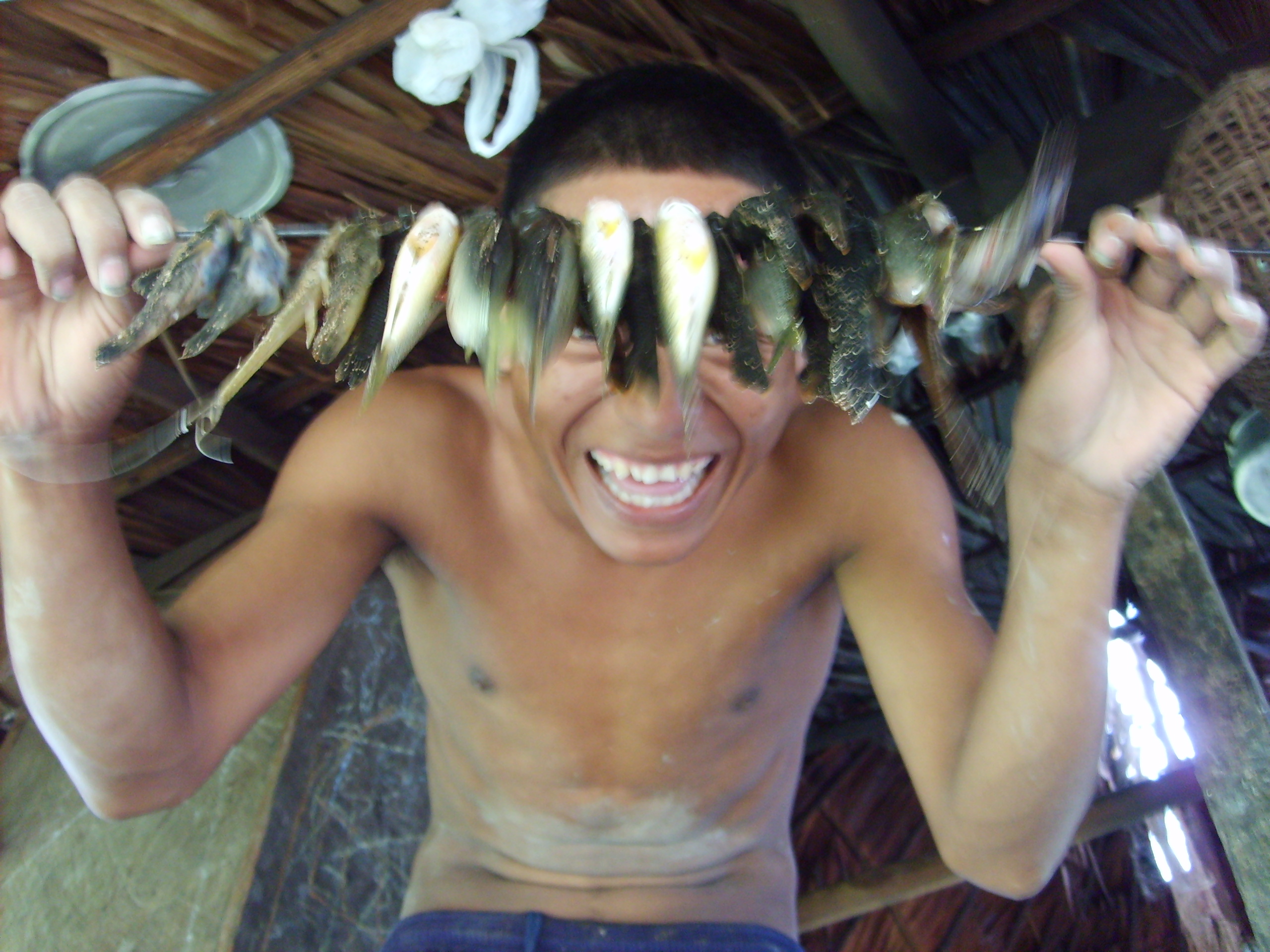The boat captain called 2 days after he was supposed to pick us up. We told him we´d discuss things and call him back. He asked us to hurry because he was dangling in the top of a mountain apple tree, the only place he could get a cell signal. I was anxious to go somewhere because Colleen and Kalea had made the wise decision to stay home in Catrigandí, and I was stuck in Yaviza at the end of the Pan-American highway on the frontier with Colombia… I wanted to get to work or get home. We got clearance from the police, found a different boat, and decided to go ahead with the trip upriver. This would be the second trip of the disaster relief project prompted by last year´s flood and the goal was to inspect water systems in 4 communities and devise a community water/sanitation plan. Ten minutes after leaving the port in Yaviza, in the late morning, it started to rain. Passengers bailed water from the giant canoe as we plodded on, joking about hot coffee and sweetbread. Four hours later when we arrived at the community, Vista Alegre, it was still raining. I pride myself on being adaptable and easy going, but I must admit that I was at my comfort limits as I searched for dry clothing in my wet bag, thanking God that Colleen and Kalea had decided to stay at home. I felt like the rat I had seen the day before, stranded on a rock in the river, shivering, uncertain, with nowhere to go. I crawled into a hammock and sulked until dark, angry with myself for having been ill-prepared. The rains began to let up, and I shooed a dog out of the cleanest corner of the smoky hut to lay down my mat and sleep. While it was still dark, Pastor Ricardo and I were awakened by voices and commotion under the house. Wow these folks get an early start, I thought, but something didn´t seem right, it was 3:30 in the morning. Ricardo´s first language is Woumeo, so I asked him what they were saying. ¨The waters are rising.” We descended from our dry cozy house to see a straggling of people carrying bags of cement. Wandering a dozen yards in the direction from which they came, we found the slowly encroaching ¨shore¨, a chocolaty filth of debris laden water where there was none the day before. My soon-to-be-friend Pedro had erected a lounge chair in the dim light at the water´s edge, reluctantly moving his chair as necessary to accommodate the rising water.

Pedro and I hold ¨borojoa¨ branches, the much revered and little understood fruit that costs 1/10 of a man´s daily wage. Pedro taught me the secret to getting all female plants when planting anew. We´ll see if I can put it to practice.
Pedro Mémbora left Panama at 17 years old with his 4 siblings, father, and pregnant mother for the jungles of Colombia at his father´s behest. His mother gave birth, and 15 days later Pedro´s father left with another woman to return to Panama, leaving Pedro to raise his siblings. This he did and did well… two earning college degrees to work as professionals in Colombia, an unfathomable achievement for the impoverished indigenous in the jungle peripheries of that country. Five years ago, the FARC (Armed Revolutionary Forces of Colombia) showed up in Pedro´s home and gave them three choices: 1) grow coca 2) leave 3) or die… so they left their home in Colombia for Panama. Pedro now resides in Vista Alegre, about 4 hours in dugout canoe up the Tuira River from Yaviza. Ironically, his father and mother live there, too… separately. Pedro has been instrumental in organizing other refugees, utilizing materials from failed government projects to build bathrooms for himself and his neighbors. He is an inspiration and a reminder of who we are here to serve… whoever we can. As for the water system in that community, we were able to inspect it as the flood waters resided, and hopefully we can provide a solution by the dry season. Although I deeply regret the devastation that the flood caused the community (it destroyed much of the plaintain crop amongst other things), it was helpful to see what we are dealing with when it comes to disposing of human waste. It was also helpful to a team of USAID workers who happened to be visiting at the same time. They were there to train the community in flood preparedness and evaluate the community in this regard. Of course, they got a first-hand experience because they had to be evacuated by the community from the flooded public school where they were staying. Here are a few videos of what we saw. I think that is a pit latrine behind where the mother and daughter are wading. I imagine a wave of sickness will follow this latest flood.
Be Well,
alan
[youtube=http://www.youtube.com/watch?v=DnEVkde2aIs&rel=0]
[youtube=http://www.youtube.com/watch?v=4E1jQDSPeqU&rel=0]
[youtube=http://www.youtube.com/watch?v=ArkPaaHpaDE&rel=0]



















![DSC_0389[1]](https://www.faithandfruit.comwp-content/uploads/2011/08/dsc_03891.jpg?w=300)
![DSC_0361[1]](https://www.faithandfruit.comwp-content/uploads/2011/08/dsc_03611.jpg?w=199)





![466px-Yin_yang.svg[1]](https://www.faithandfruit.comwp-content/uploads/2011/07/466px-yin_yang-svg11.png?w=300)




